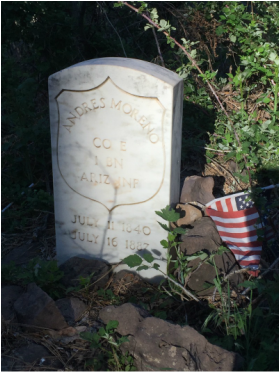
My son and I were camping this week up on the Mogollon Rim country, near an unassuming little spot called Potato Lake. On our way out to the paved road we happened along an isolated marble grave marker just off the side of Forest Service Road 300. Since such markers are unusual here, I stopped to take a look, and was rewarded with a piece of Arizona history.
The marker was made of fine marble, engraved with the restrained description of the interred: Andres Moreno, b. 1840 d. 1887, of 1st Battalion, Company E, Arizona Infantry. As my son and I pondered the fate of this man who met his end 25 years before Arizona would become a state, a small herd of elk passed quietly behind the marker. Who was this man? What sort of pitched battle must he have been involved in to find his end here, in 1887?
Enter Google. Andres Moreno was a Mexican from Sonora whose family moved north to Tubac when he was in his teens. The Gadsden Purchase granted him American citizenship, and in 1865 he joined the Arizona Volunteer Infantry, which was being put together hastily to shore up Army duties in the Territory while Army regulars were being sent back East to fight in the Civil War.
The Arizona Volunteer Infantry was a hard-riding lot, or should I say hard-marching, as they left Tubac, AZ and marched all the way to Fort Whipple, near Prescott. They spent a hard year fighting marauding bands of Apache with almost no support or meaningful resupply, and when their enlistment was up in 1865, they were grossly underpaid by a nearly bankrupt Territorial legislature who could only offer them their praise.
Moreno left for New Mexico, where he courted and married a Delfina Mazon, with whom he had several children. He became a freighter, and this trade returned the family to Arizona, where the family once again sought their fortune on our soil from Barth to Globe.
In 1887, Moreno contracted with a doctor and a lawyer, both going to Flagstaff, one to catch a train headed west and the other to assume a teaching position. Knox Lee, the lawyer, and Moreno engaged in a spirited dispute over who was responsible for providing the food for the journey, and this dispute came to a head along Baker’s Butte, on what is now Forest Road 300. Moreno and Lee were detained to repair a harness, and while Moreno was bent over his work, Lee shot him in the back of the head. He then re-arranged the crime scene to appear as though he shot Moreno in self defense.
Dr. Cook was able to ascertain that Lee’s story held no water, and Lee faced murder charges in Prescott. Sadly, anti-Mexican sentiments ran high in 1887, and Lee was sentenced to the lighter charge of involuntary manslaughter; he was able to conduct a political letter-writing campaign to turn this into a pardon only a few months into his sentence.
Moreno’s grave remained unmarked for 60 years until his great-grandson Frank Moreno was able to locate the site in 1964 and petition the Veteran’s Administration to provide the headstone I saw, which was put into place by Forest Rangers.
As we head into Memorial Day weekend, I am struck by the serendipity by which I encountered this headstone and the story that accompanies it. As we pass through this world, we owe our history, and our memory, to those we leave behind, even generations later. It is to them that we entrust our stories, and our legacy, and that is the honorable burden each of us bear for the heroes who have passed before us.
Works Cited
Brown, Stan. “The Wild West in the Rim Country,” PaysonRoundup. Nov 30, 2011.
Web. May 27, 2016

 RSS Feed
RSS Feed
